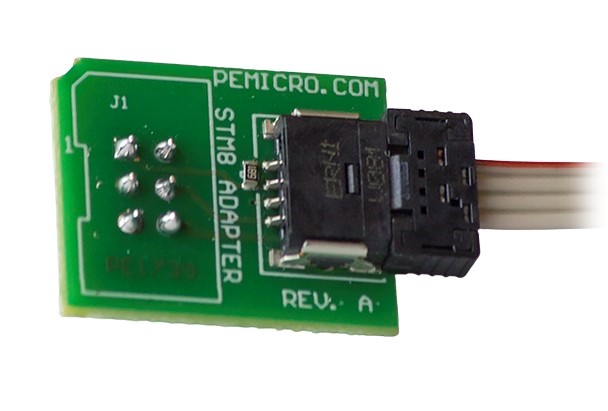Description
The Cyclone LC Universal (U-CYCLONE-LC) is the high-end model of PEmicro's in-system standalone programmers compatible with ARM Cortex-M and 8/16/32 bit processors from numerous manufacturers including NXP, STMicroelectronics, Cypress, Infineon, Silicon Labs and many more. The Cyclone LC Universal model features 16 Mb of memory to store 8 programming images, advanced security and automation features, and superior programming speed of up to 25 Mbps.
The Cyclone flash programmers are powerful tools for in-circuit programming, debugging and testing of microcontrollers. The Cyclones can be operated stand-alone or controlled from a PC. Programming can be started by a single keystroke without a PC or automatically from a PC via the automated control SDK. All Cyclone programmers can additionally be used as debug probes during development and are supported by many IDEs.
Features
- Can be operated via PC or stand alone
- Program MCUs with a PC or without a PC
- Powerful automation control
- PC-based SDK, console and GUI control, gang programming, dynamic data programming
- Multiple communication interfaces including USB 2.0, Ethernet and serial ports
- LCD display and intuitive touchscreen controls
- Easy-to-use touchscreen interface with remote access
- Target Power Management
- Ability to power the target MCU
- Automatic counting & common serial numbers
- Programming can include complex serialization
- Ethernet-based debugging
- Compatible with many development IDEs
- On-board memory
- Programming control port
- 10-pin connector for starting programming and retrieving status and programming validation
- High-speed programming
Internal memory for programming images
The Cyclone programmer can store a number of SAP (Stand-Alone Programming) images in its non-volatile, encrypted memory. Once an image is added to the Cyclone, it remains in Cyclone memory until it is deleted. Images can be added to and removed from the Cyclone individually.
A SAP image (Stand-Alone Programming) is completely self-contained and stores in itself all binary data, algorithm information, settings and programming steps for programming. In encodes all required additional information such as serial numbers and how they count. Cyclone LC models have 16 MB of memory for up to 8 images.

Connection to the target processor
The Cyclone Universal LC allows stand-alone communication or communication through a Windows computer and the target processor's in-system debug port. Connections to the respective target MCUs are supported via the Cyclone Universal LC's various headers. The headers are easily accessible by simply flipping open the plastic enclosure. All ribbon cables needed to support the variety of architectures are included as standard.
Power supply of the target microcontroller

Cyclone programmers can be used with a variety of power management configurations:
- Independently powered target : The Cyclone does not generate power for the target in this case.
- Power supplied by the Cyclone: The Cyclone can generate between 1.8 V and 5.0 V at 500 mA. This current can be routed through the ribbon cable to the target or to the current output jack on the Cyclone.
- The power is provided externally and switched via the Cyclone: The user provides power via a power input jack on the Cyclone. The switched output, controlled by the programming image, is routed to the current output jack on the Cyclone.
- The Cyclone screen contains icons that indicate the status of the power relays (on/off) and the detection of the target power.
Security & Encryption
All Cyclone programmers include anti-tamper technology and internal memory protection and encryptionProcryption Security
Depending on the production environment, many users may want additional safeguards to protect their valuable intellectual property.
CYCLONE FX programmers include Procryption Security, a set of advanced security and encryption features, such as:
- RSA/AES image encryption
- Limit date range of image programming
- Limit the number of programming operations
Procryption Security is free of charge for all Cyclone FX Models included and can be added via upgrade for Cyclone LC models.
Serial Number
When manufacturing a microcontroller or microprocessor-based product, it is often useful to program a unique serial number into the product's permanent memory (FLASH). PEmicro has developed a serialization mechanism to automate this process. Each time you enter a serialization command in the programming software, the current serial number is programmed at a specific address. In addition, the serial number is incremented to the next available serial number and stored for future serialized programming operations.
Shared serial numbers are also supported, where different programming images can use the same set of serial numbers.
Programmiermodes
Stand-alone programming - Manual control
Once a programming image is in the Cyclone's memory, programming can be initiated simply by pressing the Start button. Detailed information about the programming result can be seen on the LED screen. The currently selected image can be changed on the Cyclone via touchscreen.
The automatic provision of the target processors with serial numbers, as specified by the image, is fully supported even without a PC.
Independent programming of an image can be started manually in several ways:
- Using the start button on the device housing (one-touch programming)
- Using the touchscreen LCD menu
- Stand-alone programming can also be fully automated from a PC.
Stand-Alone Programming - Automated
Stand-alone programming can be controlled automatically from a PC using the Cyclone Control Suite, which is included free of charge.
The goal is to provide complete control of one or more Cyclones from the PC, either through the Cyclone GUI, a custom application, or the Cyclone command line. This includes starting programming, restoring results, managing images that reside on a Cyclone, adding unique programming data for each target, and more. All of this is automated and can be done without an operator. The simplest basic control of programming looks like this:
1. the host PC command package starts programming
2. cyclone image was programmed into the target
3. cyclone transfers and validates the successful result or error to the PC
The three components of the Cyclone Control Suite allow you to automate the control of a standalone programming image from a PC in a variety of ways:
- Cyclone Control Console (command line utility) . Start programming, restore the result, and optionally modify a programming image in a Cyclone via the command line or in a batch file.
- Cyclone Control SDK (.dll) . Enables integration of programming control into user applications. Allows launching programs and restoring results from a Cyclone controlled directly from the user's own application.
- Cyclone Control GUI (graphical user interface) . Allows the user to add and remove an SAP image, access Cyclone and image settings and properties, add additional licenses to Cyclone, and more.
Available software

Windows development environments
PEmicro's Windows development environment lets you run external programs - including assemblers, C compilers, debuggers, and Flash programmers - in one environment, each with a single hotkey. Editor features include: Full reconfigurability, execution of external programs, on-screen help.
Cyclone Control Suite
The suite is a free tool for automation that includes a GUI, a command line and a software development kit (SDK). The SDK includes an API that allows, for example, simultaneous control of multiple Cyclones in a user-defined program, as well as a DLL in C, C++, Java, Python, Delphi, C# and Labview.
GDB Eclipse Server Plugin
The GDB server plug-in allows the user to integrate with any Eclipse-based ARM IDE and supports multilink, Cyclone and OpenSDA debug hardware interfaces. The following debug functions are available: Flash programming, execution control, breakpoints, watchpoints, stepping and value checking.
Programming Software
PEmicro Flash programming software can be used to reprogram or rewrite internal and external Flash devices. Different GUI versions with command line assembles for specific architectures from a variety of manufacturers are available. All programmer software versions are included free of charge in the scope of delivery of a Cyclone, although this must be purchased additionally for Multilinks.
Debugger Software
PEmicro's debugger software is a powerful tool for debugging code. The user connects to the target processor via one of PEmicro's compatible hardware interfaces. The processor's debug mode can then be used to give the user access to all on-chip resources.
Unit Software Bibliothek
A UNIT software package consists of an interface DLL and sample code that can be used to create a custom application that can interact and troubleshoot with a target device via one of PEmicro's hardware interfaces or to perform functions such as product testing, calibration, and updating. Free for ARM Cortex-M.Technical Data
| Supported ARM Series |  Cyclone LC ARM / LC Universal / FX ARM / FX Universal |
|---|---|
| Atmel | SAMxxx |
| AutoChips | MCU |
| Cypress | CCG2, CCG3PA, EZ-BLE-PSoC-PRoC, EZ-BLE-PSoC6, FM3, PRoC-BLE, PSoC5, PSoC6 |
| Geehy | APM32 |
| GigaDevice | GD32 |
| indie Semi | User Experience |
| Infineon | PSoC4, PSoC6, Traveo-II, XMC |
| Maxim Integrated | Darwin |
| Mindmotion | MM32SPIN |
| NordicSemi | nRF51, nRF52, nRF53 |
| Nuvoton | NuMicro |
| NXP | Automotive, iMX, Kinetis, LPC, Sensors, Trimension, Vybrid, Wireless |
| OnBright | OB90Rxx |
| ON Semiconductor | RSL10 |
| Qorvo | Intelligent Motor Controllers |
| Rasperry PI | RP2xxx |
| Redpine Signals | WiSeMCU |
| Renesas | RA, SmartBond, Synergy |
| Silergy (Maxim) | AM0x, AM1x, MAC716xx |
| Silicon Labs | EFM32, EFR32, SiM3, WiFi |
| STMicroelectronics | Bluetooth, STM32 |
| Texas Instruments | LM3S, LM4, MSP, SimpleLink, TM4C12x |
| Toshiba | TX00, TX03, TX04 |
| WIZnet | W7500x |
| ZHIXIN | MCU |
| Supported 8/16/32 bit Series |  Cyclone LC Universal |  Cyclone FX Universal |
|---|---|---|
| S32 | ✔ | ✔ |
| NXP ColdFire® V1 | ✔ | ✔ |
| NXP ColdFire® V2/V3/V4 | ✔ | ✔ |
| NXP MPC55xx-57xx | ✔ | ✔ |
| NXP ARM Nexus MAC7xxx | ✔ | ✔ |
| NXP DSC | ✔ | ✔ |
| NXP S12Z | ✔ | ✔ |
| NXP HC(S)12(X) | ✔ | ✔ |
| NXP HCS08 | ✔ | ✔ |
| NXP HC08 | ✔ | ✔ |
| NXP RS08 | ✔ | ✔ |
| NXP MPC5xx/8xx | ✔ | ✔ |
| NXP HC16/683xx | ✔ | ✔ |
| STMicro SPC5 | ✔ | ✔ |
| STMicro STM8 | With Adapter | With Adapter |
| Infineon AUDO TC1xx | ✔ | ✔ |
| Infineon AURIX TC2xx / TC3xx | ✔ | ✔ |
| Renesas H8/H8S/Tiny | X | With Adapter |
| Renesas MC16C/MC16C80 | X | With Adapter |
| Renesas M32C | X | With Adapter |
| Renesas R8C/RH850/RL78 | X | With Adapter |
| Renesas RX600 | X | With Adapter |
| Model Comparison |  Cyclone LC Universal / LC ARM |  Cyclone FX Universal / FX ARM |
|---|---|---|
| Advanced security features |
|
|
| Internal memory | 16 MB | 1 GB |
| High speed MCU communication | Up to 25 Mb/s | Up to 75Mb/s |
| Expandable SDHC memory card connector | None | Includes SDHC card support for saving programming images and data to external SDHC cards |
| Advanced hardware functions | None | Select and start programming via barcode scanner |
Multiple SAP Programming Images | Internal memory for up to 8 programming images | Internal memory for up to 500 programming images |
| Control and automation |
|
|
| Advanced test functions | None | Carrying out tests before final programming |











.jpg)
.jpg)
.jpg)
.jpg)



